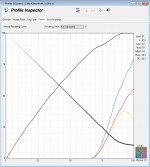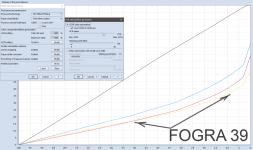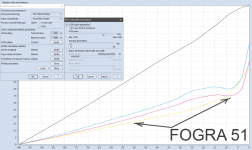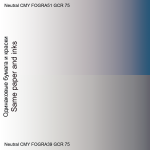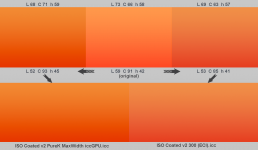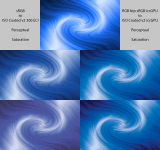mihas
Active member
Spectralcalc iccGPU™ introduces new possibilities for offset color separation.
Published for commercial use at: https://cielab.xyz/spectralcalc_en.php
The first year of use is usually free.
iccGPU uses a graphics accelerator whenever possible for the first time in the history of computer color management, so the GPU is in the name.
The clear step-by-step design of profiles allows the color technologist to control the process with the help of tables as deeply as no program can intervene at any intermediate stage. In fact, the colorist becomes a co-author of the programmer when creating the separation profile.
I made three color separation profiles for Fogra 39 in Spectralcalc iccGPU:
ISO Coated v2 Perceptual Skintones iccGPU - for maximum black width, a fundamental exception is made in the Perceptual table to achieve traditional skintones with a minimum of black ink. The Relative colorimetric table does not exclude the maximum black width for skin like it does in the Perceptual table.
ISO Coated v2 Heavy GCR iccGPU - profile with maximum black width and Heavy GCR generation for monochrome and achromatic images.
ISO Coated v2 BTAC 240 iccGPU is a profile with maximum width and blended black generation with the lowest possible offset lightness of a blend of achromatic super black (~ 60-42-38-100), but TIL=300 in chromatic colors. For any photographic image, except for skintones and achromatic, for them - the first and second profiles are better suited.
Idealliance specifications are similar to ISO.
All three profiles use magenta and cyan inks UCA and yellow anti-UCA to achieve the best possible print contrast with separations from the profiles shown. All profiles in the Relative tables use a very special maximum black ink width, which allows you to extract the highest possible pure saturated color from process printing. Wherever possible, the third contaminating color ink is replaced by black, which has less effect on the reduction of saturation and only adjusts the lightness. Thus, all 4 colors are found in color separation almost only in balance neutral and weakly saturated near-neutral colors close to it.
In the creation of non-colorimetric tables Perceptual and Saturation, the unique capabilities of the chromatic adaptation algorithm CIECAM02 are used. The Perceptual Skintones profile makes skin a little purer when separating with Perceptual Rendering Intent. RGB colorants are usually lighter than CMY colorants, so the Perceptual and Saturation tables, to preserve the saturation of the original, slightly lower the lightness of the colorants to maintain their maximum saturation in darker CMYK process colors. This perceptual gamut mapping is shown schematically in the screenshot.
Product support: cielab.xyz(at)gmail.com

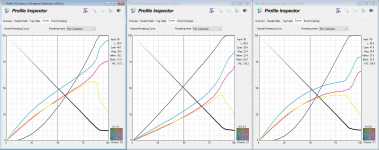
Published for commercial use at: https://cielab.xyz/spectralcalc_en.php
The first year of use is usually free.
iccGPU uses a graphics accelerator whenever possible for the first time in the history of computer color management, so the GPU is in the name.
The clear step-by-step design of profiles allows the color technologist to control the process with the help of tables as deeply as no program can intervene at any intermediate stage. In fact, the colorist becomes a co-author of the programmer when creating the separation profile.
I made three color separation profiles for Fogra 39 in Spectralcalc iccGPU:
ISO Coated v2 Perceptual Skintones iccGPU - for maximum black width, a fundamental exception is made in the Perceptual table to achieve traditional skintones with a minimum of black ink. The Relative colorimetric table does not exclude the maximum black width for skin like it does in the Perceptual table.
ISO Coated v2 Heavy GCR iccGPU - profile with maximum black width and Heavy GCR generation for monochrome and achromatic images.
ISO Coated v2 BTAC 240 iccGPU is a profile with maximum width and blended black generation with the lowest possible offset lightness of a blend of achromatic super black (~ 60-42-38-100), but TIL=300 in chromatic colors. For any photographic image, except for skintones and achromatic, for them - the first and second profiles are better suited.
Idealliance specifications are similar to ISO.
All three profiles use magenta and cyan inks UCA and yellow anti-UCA to achieve the best possible print contrast with separations from the profiles shown. All profiles in the Relative tables use a very special maximum black ink width, which allows you to extract the highest possible pure saturated color from process printing. Wherever possible, the third contaminating color ink is replaced by black, which has less effect on the reduction of saturation and only adjusts the lightness. Thus, all 4 colors are found in color separation almost only in balance neutral and weakly saturated near-neutral colors close to it.
In the creation of non-colorimetric tables Perceptual and Saturation, the unique capabilities of the chromatic adaptation algorithm CIECAM02 are used. The Perceptual Skintones profile makes skin a little purer when separating with Perceptual Rendering Intent. RGB colorants are usually lighter than CMY colorants, so the Perceptual and Saturation tables, to preserve the saturation of the original, slightly lower the lightness of the colorants to maintain their maximum saturation in darker CMYK process colors. This perceptual gamut mapping is shown schematically in the screenshot.
Product support: cielab.xyz(at)gmail.com






